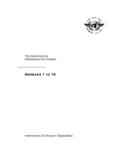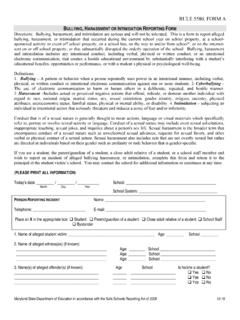Transcription of THE THREE ‘GUNAS’ AND HUMAN NATURE
1 GUNAS The Triadic Key to Yogic Psychology Peter Wilberg 2007 BEYOND BIPOLAR MORE ON THE THREE MEDITATING THE GUNAS WITH THE NEW GU-RU AND THE FOURTH GUNA NIRGUNA ..9 THE GUNAS AS BASIC RELATIONSHIPS TO FROM THE 2 BEYOND BIPOLAR PSYCHOLOGY Along with the decline and loss of the centuries-old Western physiology of humours or humors such as bile or phlegm (hence the phrase in good humour ) went the decline too of a psychology and characterology of the four basic HUMAN moods or temperaments the melancholic, sanguine, choleric and phlegmatic. Earlier medical understandings of the humours have long-since been replaced by a purely biological physiology of hormones and neurotransmitters in the brain.
2 Similarly, an age-old psychology and characterology of the four temperaments has been superseded by an ever-increasing host of psychiatric disorders and/or genetic dispositions . As a result, the whole language of Western psychology has become thoroughly dualistic - a dualism that pervades the everyday language and experience of the HUMAN being. Thus we speak of feeling positive or negative , good or bad , cheerful or sad , high or low , and of our energy , motivation or mood going up or down . Western psychiatry, in its own current terms, is dyadic or bipolar ( manic-depressive ). Worse still, the very use of the modern psychiatric term mood disorder shows how we have come to associate moods as such with disorders such as anxiety and depression - instead of understanding them as underlying tones and colourations of feeling.
3 Moods in all their variety understood as basic chords of feeling that shape, tone and colour our whole awareness of ourselves, our bodies and the world around us - are no longer recognised as an integral and indeed necessary dimension of HUMAN experience - comparable to deep musical chords. Instead they are confused and identified with their surface expression as emotional or somatic states, forms of behaviourial disorders or chemical imbalances of the brain. This is like confusing our experience of the deep, inwardly felt meaning of music with the emotional labels we might apply to it, or even reducing the 3felt qualitative meaning of music to its measurable, quantitative effect on specific regions of the brain. In the light of the dualism or bipolarity that rules not only modern Western psychology but most people s everyday emotional experience of life, we may be thankful that Indian yogic philosophy has left us with a deeper spiritual physiology and psychology a triadic language of THREE basic and innate Gunas or qualities called Tamas, Rajas and Sattva.
4 These are understood - like the humours of old - not just as basic qualities of HUMAN NATURE but also as basic qualities of NATURE as such. In their different combinations, they are understood as elemental constituents of matter making up the natural universe as a whole - and giving shape to our individual HUMAN NATURE in particular. Each of the THREE Gunas Tamas, Rajas and Sattva can balance, colour, dominate or alternatively transform and transmute into one another. Each individual s mood is always an embodiment of a different combination of the THREE Gunas - each of which constitutes a fundamentally different way of feeling ourselves and relating to the world. Tamas (black, meaning darkness or obscurity ) is felt as dullness or darkness of mood, and as physical inertia, heaviness or lethargy.
5 Rajas (red) is felt as agitation, desire, impulse, intent and passion, and is expressed as physical tension, agitation and activity in all its forms. Sattva (white) is felt as pureness, radiance, calm clarity, balance and buoyant lightness of being. The Gunas .. successively dominate, support, activate, and interact with each other. Sattva is buoyant and shining. Rajas is stimulating and moving. Tamas is heavy and enveloping. Ishvarakrishna Samkhyakarika, translated by Gerard J. Larson 4 The triadic NATURE of Guna psychology is important because it is simply truer to HUMAN NATURE than the bipolar Western psychology. A simple example will suffice: if we cannot feel dull, heavy and fatigued (Tamas) how can we rest or enter into deep sleep thus allowing us to process our experience in our dreams and to wake up feeling once again clear and bright (Sattva) and refreshed with renewed vitality and power of action (Rajas)?
6 In waking life too, if we cannot tolerate Tamasic states in which our consciousness feels dull, murky or clouded - or if physical inertia, lethargy or fatigue did not restrain us from getting lost in the whirl of everyday desires, drives and activities (Rajas) then we would not feel the need or take the opportunity to rest or meditate our lives. Our Rajasic vitality itself is thus drained but not renewed. Nor do we have the chance to discover the intense Rajasic desires or emotions that often lurk under the surface of dull or dark Tamasic states - or to regain a Sattvic clarity of awareness and with it the guidance of clear insight and direction for our lives. Instead we simply experience Tamasic states as abnormal or unhealthy , labelling them as disorders such as depression , fighting them mentally and/or with the aid of medications to keep ourselves going despite them (Rajas) or to stay positive (Sattva).
7 As a result however, we end up either in even deeper and darker Tamasic states - or in truly unhealthy Rajasic states of stress , anxiety or manic hyperactivity. Psychiatry sees Tamas as abnormal and recognises only combinations of Rajas and Sattva as healthy hence the extreme alternation of Tamas and Rajas called bipolar disorder. Yet all THREE Gunas have their role to play in a natural cycle - like the cycle of waking, dreaming and sleeping states. True wakefulness has an essentially Sattvic quality, dreaming a Rajasic quality and dreamless sleep a Tamasic quality. Yet life is richer than any categories. Thus both our waking and dream lives combine all THREE Gunas in ever-changing permutations. In this way the Gunas make up the rich and colourful continuum of our lived experience.
8 5 MORE ON THE THREE GUNAS 1. TAMAS Symbolised by the colours black or dark-blue Tamas is a quality of awareness reflecting the realm of latent, murky, obscured or occult knowledge and power. In physical NATURE it finds expression as gravity and inertial mass. In HUMAN NATURE it is felt essentially as a downward-pulling sense of inertia and heaviness. If and when it dominates the individual however, it may be experienced somatically as fatigue , lethargy or lack of energy , experienced mentally and emotionally as dullness of mind, negativity or depression , expressed outwardly as laziness or sloth , or embodied as physical weight or obesity. It finds positive expression as dignified gravitas or groundedness , as depth or weightiness of character, the ability to bear , support or pull weight and to sink one s awareness down meditatively into the depths of one s body and being.
9 Essentially it is potential action and awareness experienced darkly or obscurely. Theologically it iis associated with the primordial darkness and power of the primordial mother goddess known as The Great Black One (Maha-Kali). Temperamentally it is the Guna uniting the phlegmatic with the black bile of the melancholic . Anatomically and medically it is associated with the bowels, abdomen and womb. Psychiatrically it is labelled as mild or severe depression. Sociologically it can find negative expression as the destructive potential of spiritual ignorance, generalised political apathy, the dullness of routinised work, lack of empathy and lifeless personal relationships. People search to compensate for Tamasic existence either though Rajas - hyperactivity and busyness, revelry in drugs and consumerism or mindless entertainment or through bland Sattvic states of spiritual harmony, peace and calm.
10 2. RAJAS Symbolised by the colour red, Rajas has essentially to do with the emergence of the vital impulses to outward action and motion ( e-motion ) that lay latent, obscured or blocked in Tamas. Rajas finds expression as the very process of emergence (Greek Physis ) that is the root meaning of the term physical , and with energy in the root sense of action or activity (energein). That is why the Rajas Guna is principally associated with red-blooded vitality or passion, with the impulse to act, and also hot-blooded anger and rage with seeing red , and with the aggression necessary to release blocked action or communication. Temperamentally it is the Guna uniting the sanguine 6with the choleric. Anatomically it is associated with the genitals and heart, blood and menstruation, psychiatrically with mania and paranoia.







